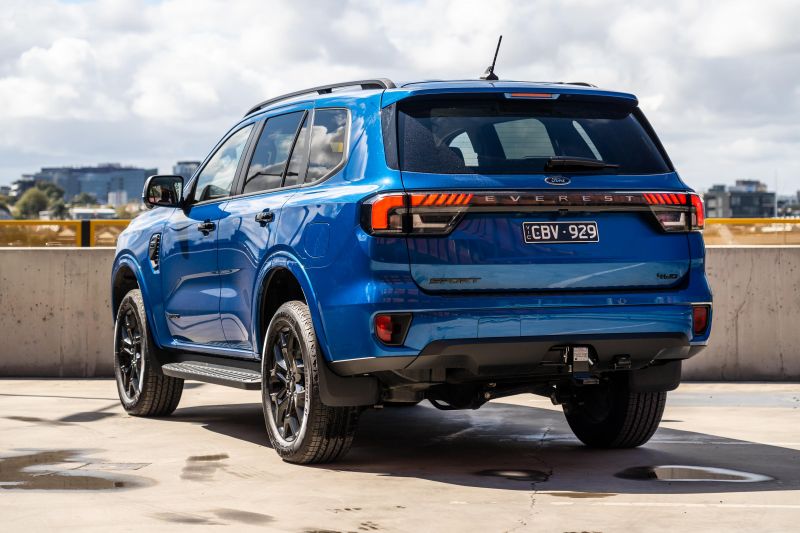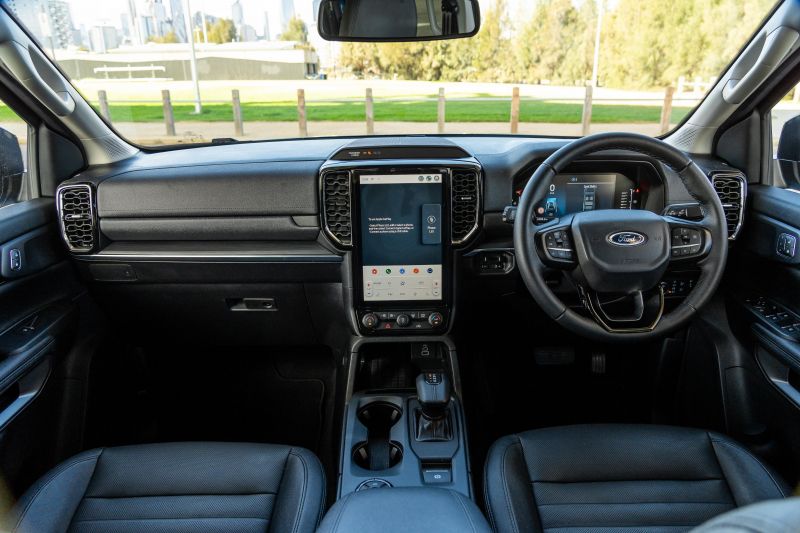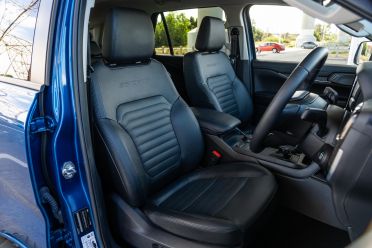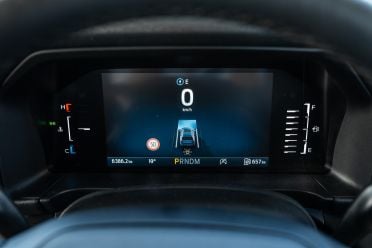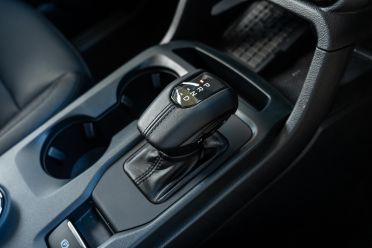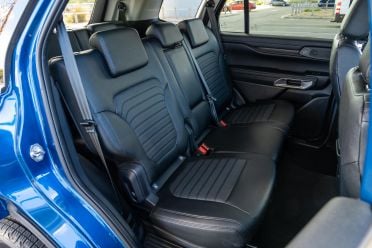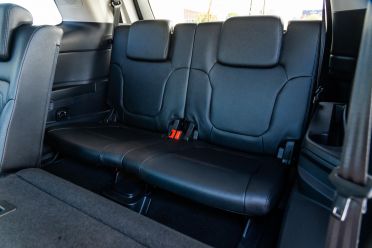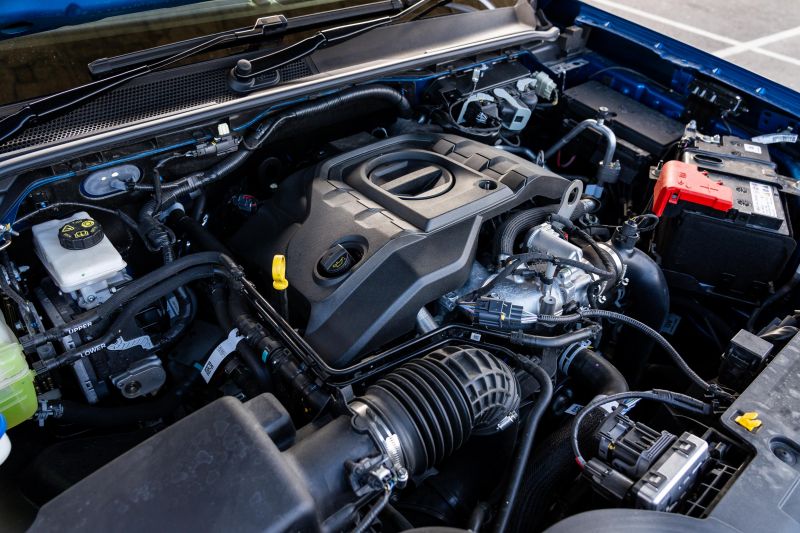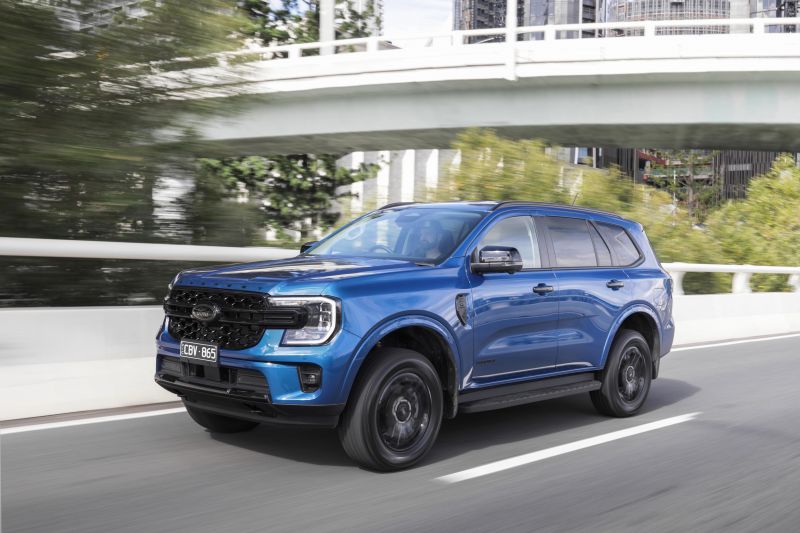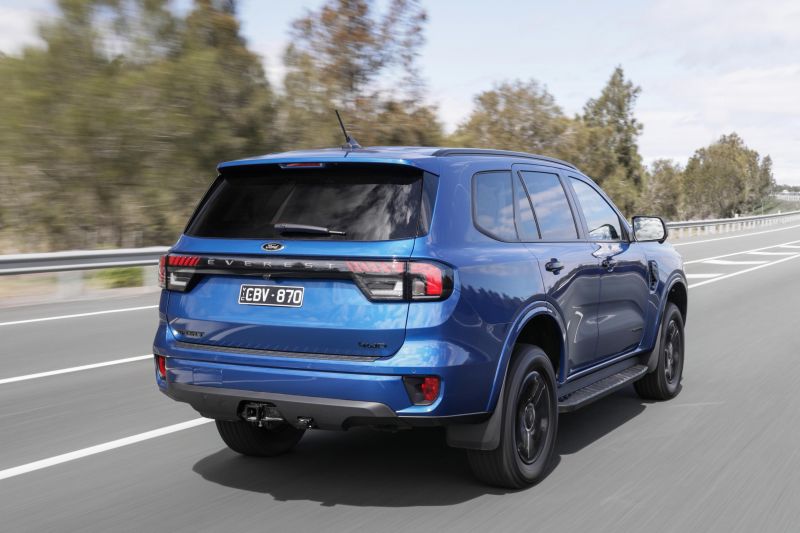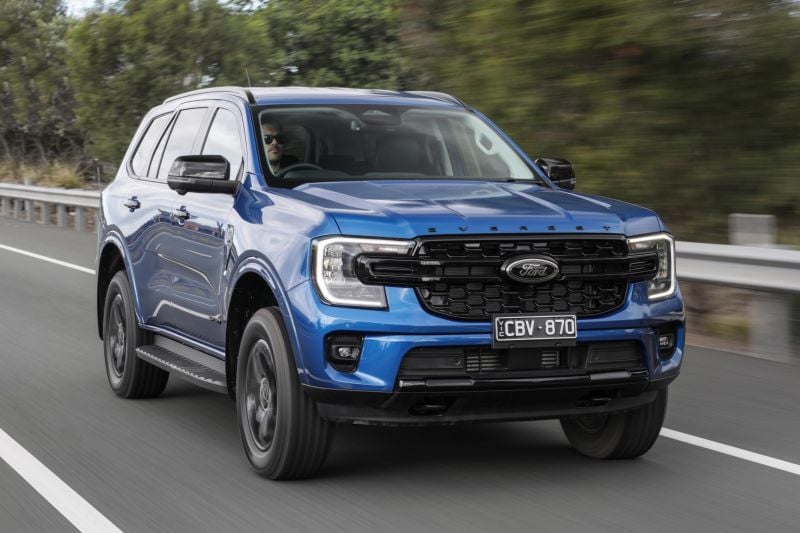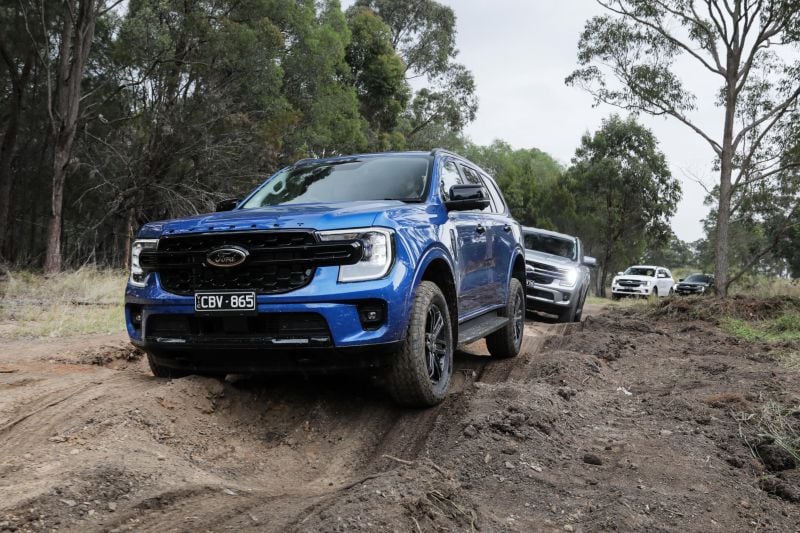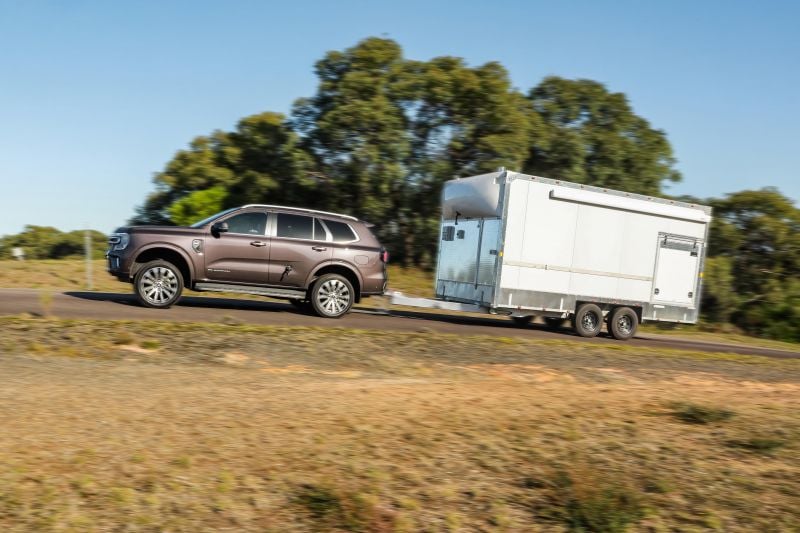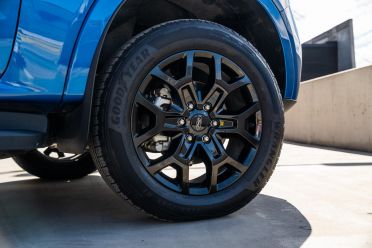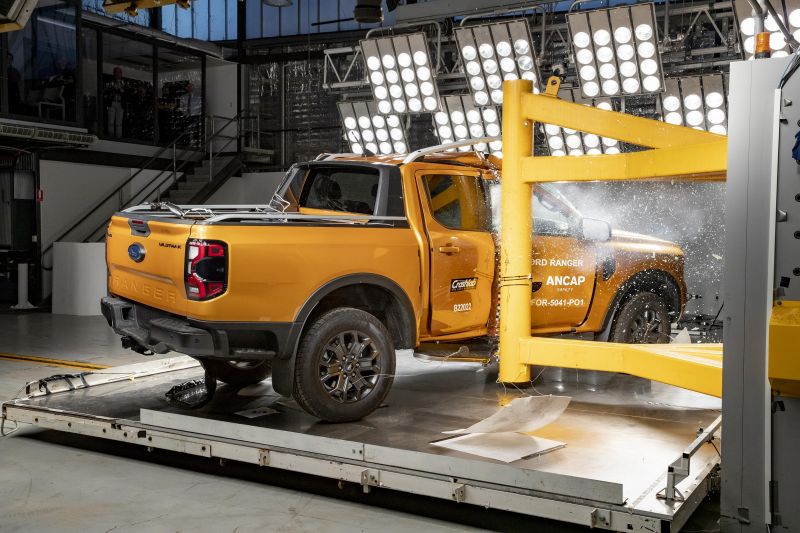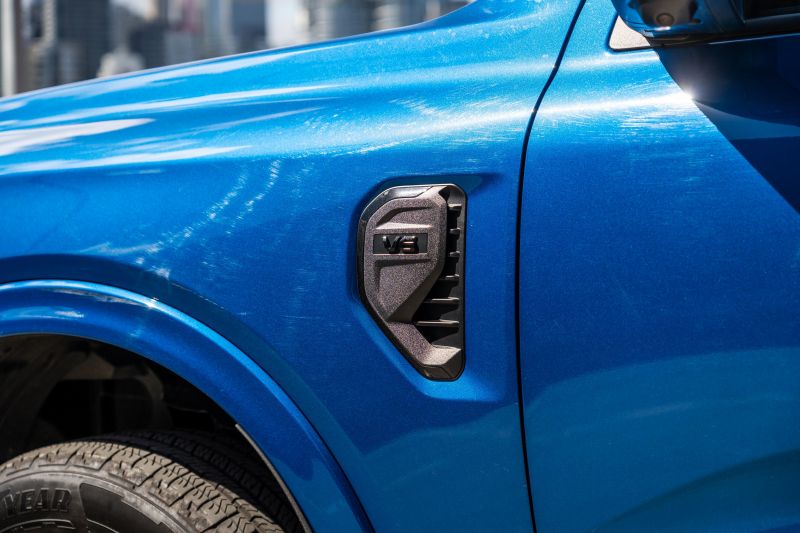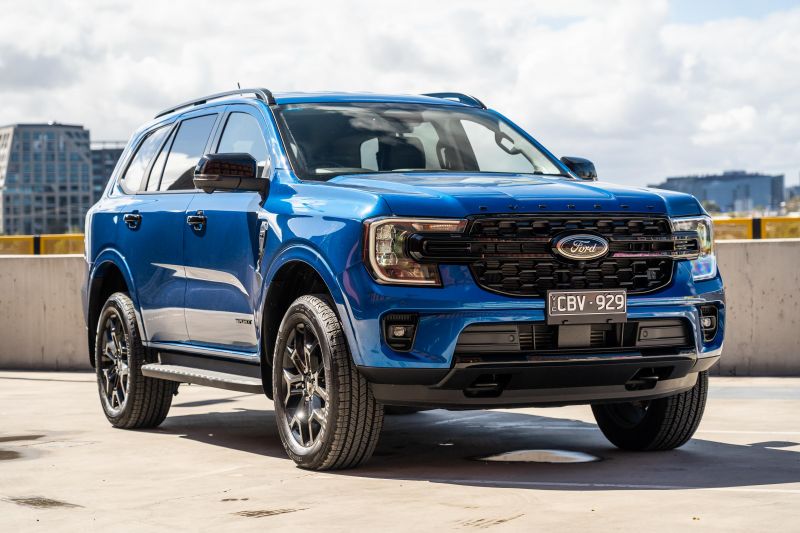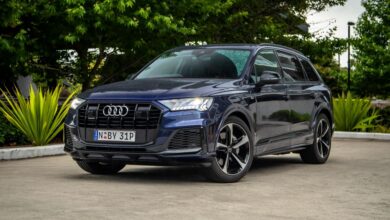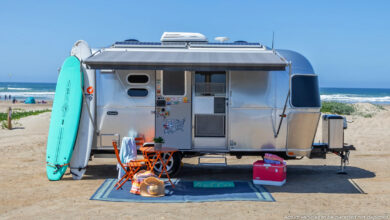2024 Ford Everest Sport 4×4 review
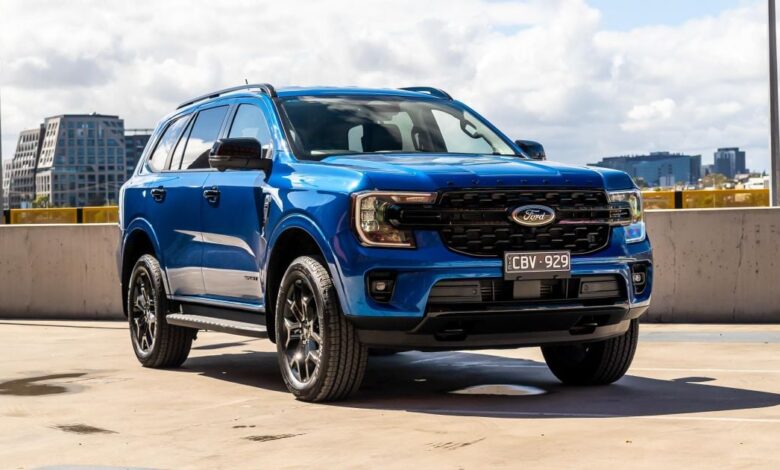
If you want to take your kids to school during the week, and take them camping deep in the wilderness on the weekend, the Ford Everest has emerged as one of the best solutions money can buy in Australia.
Along with the Toyota Fortuner, Isuzu MU-X, and Mitsubishi Pajero Sport at the bottom end of the range, the top-end Everest Sport and Platinum rub shoulders with the Toyota LandCruiser Prado, and road-oriented seven seaters like the Kia Sorento and Hyundai Santa Fe.
It really needs to be all things to all people in a way few cars can manage – and so far, it’s managed.
But things change fast in the motoring world. There’s a new Prado on the way this year, and GWM has waded into the rugged seven-seat SUV world with its sharply-priced Tank 500. Over at Hyundai, the Santa Fe seven-seater will be here with a bold and boxy new look soon for families who want to look tough on the school run, but rarely leave the blacktop.
How does the Everest stack up in the face of a wave of new competitors?
How does the Ford Everest compare?
View a detailed breakdown of the Ford Everest against similarly sized vehicles.

Ford
Everest
How much does the Ford Everest cost?
The 2024 Ford Everest Sport 4×4 V6 sits below the Platinum in the range, with a sticker price just north of $70,000 before on-road costs.
2024 Ford Everest pricing:
- 2024 Ford Everest Ambiente 4×2 Bi-Turbo: $53,990
- 2024 Ford Everest Ambiente 4WD Bi-Turbo: $58,990
- 2024 Ford Everest Sport 4×2 Bi-Turbo: $63,490
- 2024 Ford Everest Trend 4×4 Bi-Turbo: $66,790
- 2024 Ford Everest Sport 4×4 V6: $72,490
- 2024 Ford Everest Platinum 4×4 V6: $79,490
Prices include Luxury Car Tax (LCT) if applicable, but exclude on-road costs.
To see how the Ford Everest stacks up with its big off-road rivals, use our comparison tool.
What is the Ford Everest like on the inside?
Practical, rugged, and packing a pretty impressive technology suite, the Everest Sport blends the ute and family four-wheel drive worlds well.
With a tilting and telescoping wheel, well-padded seats that accomodate tall drivers, and plenty of storage up front, the Everest is easily the best 4×4 of its kind out there if you’re planning to spend long stints on the highway – at least, before you get into the LandCruiser’s realm.
Drivers of all shapes and sizes can get comfortable in there, and it doesn’t feel like you’re driving a truck despite the elevated driving position and bluff bonnet.
With an upright design and plenty of hard-wearing plastics the Ranger-derived cabin is not the last word in luxury, but this Sport also has plenty of leather, heated seats, and a 12-inch central touchscreen to bolster its top-end credentials.
Anywhere you rest your elbow is soft across the range, and the chubby steering wheel feels good range-wide, but some of the plastics in the Sport aren’t quite befitting of its price tag.
The infotainment software looks and feels very modern, and Ford has retained some physical buttons for frequently-used climate functions, so it’s easy to fiddle with the temperature on the move.
The menu structure is logical, and the sheer amount of screen real estate means key information isn’t buried. It’s possible to have your mapping, radio preferences, and climate information on display all at once, for example.
The Blue Oval has also given the software a makeover since launch, ringing in a cleaner-looking interface and fixing the intermittent wireless Apple CarPlay gremlins that afflicted our early Everest testers. It’s also snappier than those early cars we drove, with what feels like more processing power.
Despite its billing as a high-end option, the Everest Sport shares its basic digital instrument cluster with the Ranger. It’s a simple, effective unit, but it’s not quite as flashy as the 12.4-inch unit standard in the Platinum – which feels as though it really should be standard here.
Storage space around the cabin is plentiful. The central bin is deep, the door pockets have plenty of room, there are two cupholders on the transmission tunnel, and the slot beneath the dashboard is huge.
The slot ahead of the gear selector is perfect for a large McDonalds fries – no chip crisis here.
The Everest features an upper glovebox in addition to the regular glovebox. There are also pop-out cupholders on each end of the dash. Both of these are features more commonly seen in utes than in SUVs.
Step into the second row and there’s plenty of room, plus a pair of USB outlets. It’s among the best in class for rear space, and my six-foot-two parents (yes, both of them) had no trouble back there on a two-hour road trip.
The slightly raised seating position will help quell sickness by affording short occupants a decent view out the front, and the tall windows mean it’s a light, airy place to spend time. It is a bit of a step up into the cabin, even with the side steps in the Sport.
There are three top-tether mounts in the second row, and two in the third, as well as ISOFIX anchors on the outboard second-row seats.
Headroom in non-sunroof equipped cars is pretty good for tall passengers, although the tunnel (which houses the air vents) running through the centre of the roof does eat into space for the central occupant.
Where the Everest’s boxy new styling has most paid dividends is in the third row. There’s less wheel arch intrusion than before, which frees up more space for occupants, and headroom is generous enough to accomodate small adults.
Access is relatively easy with the second row slid forward and folded, and the sliding bench means you can free up more legroom for third-row occupants by slightly compromising that of people in the second row.
There are vents back there, along with 12V ports. The big windows mean third-row passengers won’t feel like third-world citizens, and the curtain airbags cover all three rows of seating.
Behind the third row, there’s 259L of cargo space, expanding to 898L with it folded and 1823L with the second row folded. With all three rows up, you can fit either two duffel bags or perhaps one suitcase, depending on its size.
What’s under the bonnet?
Ford has recently added a four-cylinder engine option to the Everest Sport, with rear-wheel drive only. Our tester had the V6 turbo-diesel option however, complete with full-time four-wheel drive.
| Model | Ford Everest Sport 4WD |
|---|---|
| Engine | 3.0L turbo-diesel V6 |
| Power | 184kW |
| Torque | 600Nm |
| Transmission | 10-speed auto |
| Driven Wheels | Full-time four-wheel drive |
| Weight | 2488kg |
| Fuel economy (claimed) | 8.5L/100km |
| Fuel economy (as tested) | 9.5L/100km |
| Fuel tank | 80L |
| Braked towing capacity | 3500kg |
| Kerb weight | 2468kg |
| Gross vehicle mass | 3150kg |
| Gross combination mass | 6250kg |
To see how the Ford Everest stacks up with its big off-road rivals, use our comparison tool.
How does the Ford Everest drive?
This is the most car-like take on the ute-based off-roader formula out there, and has been since its launch in 2022.
The V6 engine fires quietly by turbo-diesel standards, and settles into a smooth idle. The Bi-Turbo engine is pretty impressive given its small displacement, but it can’t match the V6 engine in this model for performance.
It offers a satisfying surge of performance from below 2000rpm when you lean on the accelerator, and better in-gear response at highway speeds. It doesn’t need to work as hard, and when you need to dig deep you’re immediately aware there’s a higher ceiling on what it can do.
Our towing testing has also shown it’s a more capable engine with a heavy load attached to the car as well, which shouldn’t come as a surprise given it’s up 1000cc, 30kW, and 100Nm on its little brother.
10 gears might seem like too many, but the automatic transmission is generally decisive. In town you’re rarely aware of what gear it’s actually in, slurring through the lower ratios inoffensively and kicking down smartly when you need more performance.
Ride quality is excellent by segment standards. Although you still feel the pitter-patter of pimply city roads at low speeds, it doesn’t feel like a clunky, lumbering bus in the way some rivals do, and there’s very little shimmy through the ladder frame over sharp hits.
With light steering and solid all-round visibility, it’s easy enough to place in tight places. In the old Everest (and some of its rivals) you needed to twirl, twirl, and twirl the wheel some more at low speeds; this model requires smaller inputs, which in turn makes it feel more car-like.
On the open road, the Everest impresses with its refinement. Ford talked at length about the focus it placed on cutting down on unwanted noise in the cabin, and there’s no question it’s paid off.
It puts more expensive luxury cars in the shade for noise suppression on coarse chip country highways, allowing passengers to speak comfortably across the first two rows at 100km/h. I spent almost 10 hours behind the wheel over Easter and always hopped out feeling fresh; it’s a really good place to spend time.
The lane-keep assist keeps you between the white lines on the highway and holds the car nicely in its lane in tricky conditions, and the adaptive cruise control is smooth and smart. Ford deserves points for putting the lane-keep button on the steering wheel, making it dead simple to turn off.
The handling is surprisingly good for a big, off-road-oriented bus. Rather than immediately falling over its outside front wheel, the Everest always feels planted with well-controlled body roll for a vehicle of this size and type.
The added security of a 4A four-wheel drive mode – which can be used on sealed surfaces – is welcome when the weather gets wild, because top-heavy cars on all-terrain tyres can be surprisingly sketchy on slick roads.
This is an off-roader set up for beginners. It has one of the best hill-descent control systems on the market, keeping an iron grip on the car’s momentum without any awkward grinding from the ABS, and the range of off-road modes makes it easier for nervous drivers to find the right combination of settings for whatever they’re facing.
Any inputs to the off-road dials on the transmission tunnel bring clear, bright animations on the instrument cluster or central screen to keep less experienced drivers abreast of what’s happening, and the four-wheel drive system switches modes quickly.
As for towing? Here’s how it fared in our 2023 Mega Test.
The technology in the Everest does an excellent job making it easy to set up for towing.
The camera is clear and central, and the ability to cycle through light checks automatically – either using the FordPass app, or the car’s infotainment system on a timer – mean you don’t need a second set of eyes to perform basic safety checks.
Performance is solid from the Everest V6, sitting between our four-cylinder challengers and the more expensive V6 and V8 vehicles on test. Tow Mode makes the transmission to hold gears smartly when accelerating, and sets it up to downshift proactively when going downhill for more engine braking.
It’s a shame Ford forces you to use fiddly buttons the side of the transmission selector instead of fitting paddles when it comes time to take control, however. It accelerated confidently up our steep hillclimb without setting the world on fire.
What do you get?
The Everest range is smaller than the sprawling Ranger line-up, with four distinct trim levels.
Everest Ambiente highlights:
- 17-inch alloy wheels
- All-season tyres
- 17-inch steel spare wheel
- LED reflector headlights
- C-shaped LED daytime running lights
- Front fog lights
- LED tail lights
- Black side steps
- Auto power-folding side mirrors
- Rain-sensing wipers
- Two front tow hooks
- Steel underbody protection (4×4 model only)
- 10.1-inch Sync4 touchscreen infotainment system
- 8-inch digital instrument cluster
- Wireless Apple CarPlay and Android Auto
- Embedded modem
- Wireless phone charger
- 8-speaker sound system
- Satellite navigation
- DAB+ digital radio
- Embedded voice assistant
- FordPass with remote start
- Dual-zone climate control
- 5 seats (7 seats optional)
- Fabric upholstery
- 8-way manual driver seat adjustment
- 4-way manual front passenger seat adjustment
- Driver floor mat
- Electrochromatic rear-view mirror
- Dash-mounted pull-out cupholders
- Open storage shelf
- Tilt and reach steering wheel adjustment
- Keyless entry with push-button start
- Vinyl console lid
- Electronic parking brake
- Conventional mechanical gear shifter (4×2 only)
- e-Shifter gear shifter (4×4 only)
- Locking rear differential (4×4 only)
- Push-button selectable drive modes
Everest Trend adds:
- 18-inch alloy wheels with matching spare
- Privacy glass
- Power tailgate
- Heated, power-folding side mirrors with puddle lamps
- 12-inch Sync4 touchscreen infotainment screen
- Seven seats
- Leather-accented upholstery
- 8-way power driver seat
- Leather-wrapped steering wheel
- Driver and passenger floor mats
- Upper glove box
- Off-road screen (4×4 models only)
- Rotary drive mode selector (4×4 models only)
- Sand, Mud/Ruts drive modes
- Black stand-off roof rails (NEW)
- Zone lighting (NEW)
Everest Sport adds:
- 20-inch black alloy wheels with matching spare
- Black exterior accents
- Handsfree power tailgate
- Black 3D bonnet lettering
- 10-speaker sound system
- Unique leather-accented upholstery, ‘SPORT’ embossing
- Unique interior colour accents
- 10-way power driver seat with memory
- 8-way power passenger seat
- Heated and cooled front seats
Is the Ford Everest safe?
The Ford Everest earned a five-star ANCAP rating on the back of an 86 per cent score for adult occupant protection, a 93 per cent score for child occupant protection, a 74 per cent score for vulnerable road user protection, and an 86 per cent safety assist score.
The five-star rating applies to the whole Everest range, and is based on tests carried out on the closely related Ford Ranger ute.
The 2024 Ford Everest comes with the following standard safety equipment:
- 9 airbags
- Autonomous emergency braking (AEB)
- Reverse AEB
- Post-impact braking
- Lane-keep assist
- Lane departure warning
- Driver attention alert
- Blind-spot monitoring
- Reverse camera
- Front, rear parking sensors
How much does the Ford Everest cost to run?
The Everest is backed by a five-year, unlimited-kilometre warranty like the wider Ford range.
Maintenance is required every 12 months or 15,000 kilometres, and the first five services are each priced at $379 under the Blue Oval’s capped-price service program – $50 higher per service than in pre-2024 vehicles.
CarExpert’s Take on the Ford Everest
Even with all the change coming to the ute-based and seven-seat four-wheel drive worlds, the Everest remains a class leader.
It blends impressive road manners with idiot-proof off-road technology, and a healthy dose of towing ability to boot.
The almost-range-topping Sport is a smart spec, blending a punchy turbocharged diesel V6 with a luxurious (enough) interior to justify its steeper sticker price. You might want a Platinum? Probably, but you don’t really need it.
With all of that said, we still want more from Ford. The surround-view camera really shouldn’t be buried in an option pack, and some strong competition is coming soon.
The new GWM Tank 500 offers a plusher interior for less money, while a new Toyota LandCruiser Prado is on the way. Although the Everest isn’t strictly aimed at the Prado, there’s plenty of crossover in what they’re trying to do, so it’s going to be interesting to see how they stack up.
In the meantime though, the Everest is easy to recommend.
Click the images for the full gallery
MORE: Buy a Ford Everest
MORE: Everything Ford Everest
